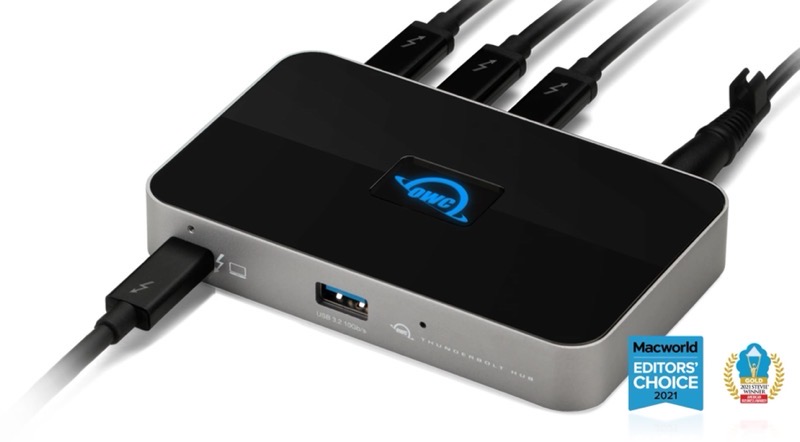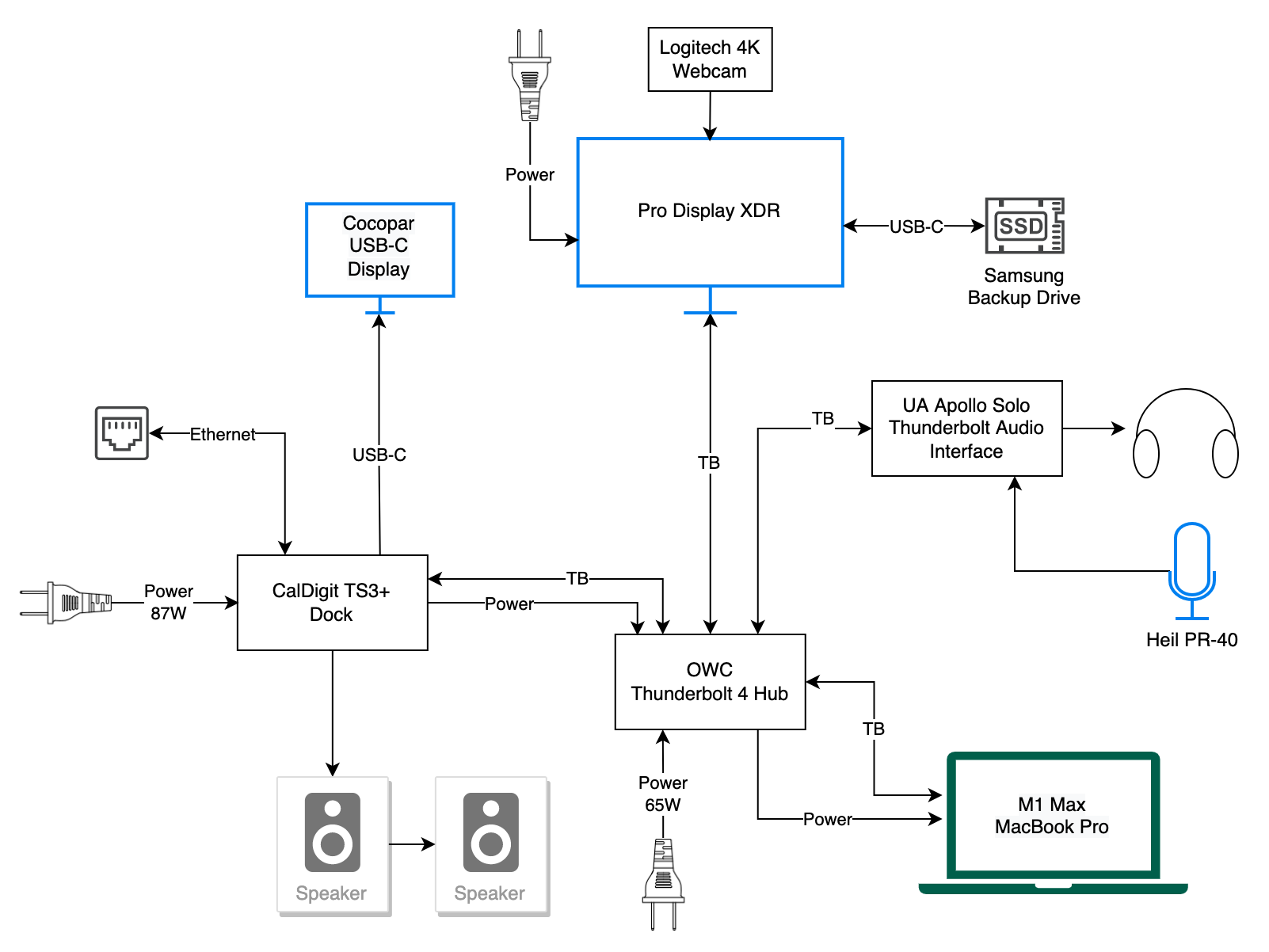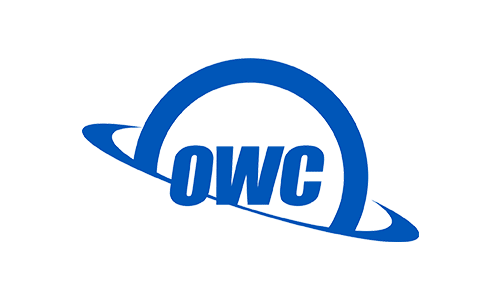
One of the great joys of the USB-C life has been the proliferation of USB-C docks that are cross platform for Mac and PC. Over the years I’ve tested a lot of them, settling on the CalDigit TS3+ dock as my favorite.
I did a full review of the CalDigit TS3+ three years ago and I still love it to pieces. This sweet little paperback-book-sized dock has 5 USB-A ports, 2 USB-C ports, 2 Thunderbolt ports, DisplayPort, Digital Optical, Gigabit Ethernet and audio in/out.
With 2 Thunderbolt ports on the CalDigit dock, you can plug in a Thunderbolt display like the 5K or the Pro Display XDR, and also plug in a Mac and get both power to the Mac and video out to the display. Add in other USB devices and some speakers and you’ve got everything with just a single Thunderbolt cable to the Mac.
At this point in my story, I’ve given you a scenario a relatively normal nerd might set up for themselves. I’m going to diverge into more complexity that has very little chance of relevance to anyone listening or reading. How’s that for a hook to persuade you not to jump to the next chapter?
This setup worked pretty swell for me until I decided to upgrade from a USB mic interface to the Universal Audio Apollo Solo Thunderbolt 3 mic interface. A mic interface allows you to use a big-girl mic with an XLR connector on it, and yet plug it directly into your Mac or PC.
I switched to a Thunderbolt interface to solve a big problem I was having.
The big problem is that USB wasn’t able to keep up with the load when I was recording video tutorials for ScreenCastsOnline. I’d get these little clicks and pops from time to time. It was super tedious to have to rerecord my voice.
Giving up USB and going to Thunderbolt has a beautiful side effect too. The only way to be truly sure you’ve got clean audio is to monitor your own voice. This drives some people bananas because USB introduces a slight delay. With a Thunderbolt interface, you can get very close to zero latency so you can monitor without losing your mind.
It turns out that there are a lot of USB interfaces, a limited choice of Thunderbolt 2 interfaces, and exactly one Thunderbolt 3 interface that fits my requirements. There are lots of huge ones with 8 mic inputs and such, but I really only needed one mic input since it’s just little old me, and I didn’t want to have to sell a kidney for it either.
The one option is the $600 Universal Audio Apollo Solo with two XLR mic inputs. I talked and wrote about it back when I got it in late August.
There are a few issues with the Apollo Solo, and one of them is that it absolutely positively has to be plugged directly into the Thunderbolt port on the Mac. I know, you’re crying with me that I have to live with the agony of plugging in two cables. But hey, when you’ve lived the one cable life, having a two is a very sad thing.
With the advent of macOS Big Sur, Apple unlocked some capability in Thunderbolt 3 (now Thunderbolt/USB 4). The change allowed Thunderbolt devices to go through a hub, just like you can with USB devices. A Thunderbolt hub might be the solution to allowing me to go back to a one-cable life.
For Christmas, Santa brought me the OWC Thunderbolt Hub, which runs a rather modest $179 US. This hub connects to your computer via Thunderbolt 4 on the front and expands to three Thunderbolt 4 ports on the back. As an added bonus they threw a 10Gb/s USB-A 3.2 port on the front.
Adding the OWC Thunderbolt Hub to your Mac is essentially adding two extra Thunderbolt ports. I said this story wasn’t relevant to most people, but if you’ve got an M1 Mac with only 2 Thunderbolt ports, the hub might actually be pretty helpful to you.
Now for me, the problem wasn’t that I didn’t have enough Thunderbolt ports, but rather I only wanted to use one port on my Mac when at my desk. I wasn’t sure the OWC Thunderbolt Hub would solve my problem, and it took some diagramming to figure out whether it could do what I needed.
I opened up my trusty, free diagramming tool Diagrams.net and got to work. My requirements were to connect:
- Pro Display XDR on Thunderbolt
- An external USB-C display on occasion
- A USB-C SSD for backups
- Universal Audio mic interface on Thunderbolt
- Hail PR-40 XLR mic into the Universal Audio interface
- Headphones into Universal Audio interface
- Ethernet through the CalDigit TS3+ dock
- Power from the CalDigit TS3+ dock to the Mac and the mic interface
- External speakers
- Logitech Webcam
This doesn’t sound like too much to ask, does it?

The CalDigit TS3+ starts the chain of happiness with power and Ethernet. Next, I can insert the OWC Thunderbolt Hub between the CalDigit dock and the Mac. The Pro Display XDR and the Universal Audio mic interface can then hang off of the Thunderbolt hub.
With the XDR and the Universal Audio interface going through the hub, this frees up a USB-C port on the CalDigit TS3+ dock, where I can plug in a portable USB-C display when I need it.
That left my SSD backup drive looking for a home. I could have plugged it into the open USB-C port on the front of the CalDigit dock, but it’s messy to have it out in front on my desk. It turns out that the Pro Display XDR has three USB-C ports on the back, which is a perfect place to discretely plug in the SSD drive along with the Logitech 4K Webcam.
I can’t get away from any mess coming out of the front of my devices, because the speakers I’m using have to plug into the front of the CalDigit dock, and the headphone jack on the Universal Audio mic interface is also on the front. Why do companies put audio jacks on the front of their devices? Does everyone but me need quick access to swap out audio devices?
It may be hard to picture in your head what I’ve described, but if you really want to follow along, the diagram makes it pretty clear I hope. It took a lot of iterations to get it right, especially with Quality Control Director Steve telling me when I had my arrows pointing the wrong way for the information flow. I think I’ve got it right but I wouldn’t be surprised if you find one more that I have flipped the wrong way!
Universal Audio is absolutely adamant that you can’t plug their mic interface into any kind of hub, but it’s working swimmingly with this configuration. In my experience of many support emails with this company is that they have a very old-school view of the audio world, and probably aren’t taking into account the glory of Thunderbolt hubbing.
Power Question
I have one question outstanding about this new setup. In the diagram, you can see that the CalDigit TS3+ provides 87W of delivery. Before I put in the OWC Thunderbolt Hub, it was this 87W of power that charged my MacBook Pro. In the new setup, the dock connects to the hub, and the hub has its own power supply which provides 65W of power delivery. Since my MacBook Pro is plugged into the hub, which of those two devices is charging my laptop? It might also be interesting to note that the power-hungry M1 MacBook Pros want 96W of power. The Apollo Solo mic interface is bus powered, which means it is drawing power from the hub as well. It took some digging, but I found the manual online for the Apollo Solo and it draws 10 Watts all by itself.
Perhaps when the hub sees 87W of power coming at it from the dock, the hub says, “Ok, it looks like you’ve got this”, and just passes that 87W along to the Mac. It’s also possible that the hub simply doesn’t deal with the power coming from the dock and simply sends its own 65W along to the Mac (less the 10W stolen by the mic interface).
A reasonably knowledgeable tech support person at OWC told me that the more powerful power supply will always win. I’ve got evidence that maybe there’s yet another option. Before I put in the hub between the dock and the Mac, if I ever used one of the USB ports on the dock to charge something, the Mac would complain that it wasn’t getting enough power and to stop that nonsense right now or it would turn the car around.
But now with two devices offering power, I can charge my iPhone via the dock and the Mac makes no complaints at all. My suspicion is that the dock and the hub somehow form an alliance and add their power delivery together, giving the laptop whatever it needs.
I’m a mechanical engineer, and my resident electrical engineer didn’t ever work on power supplies, so we don’t know the answer to these questions. If you do know the answer, I’d be very curious to know how the power is handed off between these devices. I’m happy now bcause my setup is working really well, but I just have to know!
I know this one got a bit deep into my setup that may not apply to any of you, but I’m always glad later when I refer back to articles like this. Invariably something will change in my environment, andsI’ll need to go back and ask myself, “Now how exactly did I have all that plugged in when it was working?”


Is that link to diagram.io correct?
It should be now, thanks to you. The correct link is diagrams.net. They messed me up when they changed the name away from draw.io. Even more confusing is they have a desktop app and it is called draw.io. I didn’t have a chance!
Being such a fan of the CalDigit TS3+ dock, I’m surprised you didn’t go with the CalDigit Thunderbolt 4 Element Hub. Did you consider it, or wasn’t it available when Santa gave you the OWC Thunderbolt 4 Hub? For about the same money the Element Hub provides a total of 8 ports vs. 5 on the OWC, it has 4 USB-A ports, it has a 150 watt power supply vs. 110 on the OWC, and it delivers full 60 watt charging even under a heavy load. It also has a reversible design for optimum cable management.
David – I have to confess I didn’t know that CalDigit had a Thunderbolt hub! When the OWC hub was announced, it was the only one. I’ve been waffling about whether to buy it for so long more models exist on the market. The CalDigit offering does look pretty good. I don’t need more USB-A ports as most of my devices and cables are USB-C now but for others, all those ports would be great. Thanks for letting me know about it.
It’s now the day after I posted above about the CadDigit Thunderbolt 4 Element Hub. Just received an email from Sonnet Technologies that they, too, have a Thunderbolt hub called the Echo 5 Thunderbolt 4 Hub. Features are:
o One Cable Peripheral Connection
o Three Thunderbolt 4 Ports for Peripherals
o Powerful 10Gbps Front Panel USB Type A Charging Port
o Support for 4K, 5K, 6K, and 8K @60Hz Displays
o Many Display Interfaces Supported – Connect Thunderbolt and USB-C Displays Directly; Supports HDMI and DisplayPort Displays with a Thunderbolt-compatible Adapter (sold separately)
o Travel-Sized Thunderbolt Port Expander
o Charge Your Laptop – Provides Up to 85W
o Apple M1 Compatible (Supports All Apple M1/M1 Max/M1 Pro Computers)
o Intel Mac Compatible (Supports All Thunderbolt 3 Mac Computers Running macOS 12 or 11)
o Intel Windows Compatible (Supports All Thunderbolt 4 Windows Computers)
o Apple M1 iPad Pro Compatible(Supports all iPad Pro Tablets with a Thunderbolt Port)
o 2-year Product Warranty
o Free Lifetime Customer Technical Support
o Designed in the USA
Perhaps a certain retired engineer who does a technical blogs and shows with just a small Macintosh bias would do a shootout comparing the OWC, the CalDigit, and the Sonnet? Who knows?… There may be more on the way!
Whoops… here’s the link for the Sonnet hub:
https://www.sonnettech.com/product/echo5-thunderbolt4-hub/overview.html?mc_cid=4940c14516&mc_eid=f26522c7f6
Very cool, David. I was toying with that idea when you pointed out the CalDigit option but I’m not sure I’m the best person to assess the differences. I don’t drive high-speed video to NVME drives or use multiple high res displays. I can count the ports pretty good (sometimes I’m off by one or two ) but other than that I’m not sure I’d add value.Might still be fun, though.
So glad you took the time to post this – thank you!
I am a voice actor and own two Universal Audio interfaces. The Arrow is the TB3 travel model and up til now there was no way to connect this bus powered interface to my MacBook Pro laptop except through direct connection. And with only two ports on the model I have that doesn’t leave room for much.
The OWC model looks like what I’ve been looking for which will allow me to hook up my AC in one port and everything else into the OWC TB port (SSD hard drive/Arrow audio interface/wireless usb mouse dongle/second monitor if necessary).
Since I work as a voice actress, I have invested in not one but two Universal Audio interfaces. The Arrow is a portable version of the TB3 and, until today, the driving directions only way I could use this bus-powered interface with my MacBook Pro was by plugging it in directly. The type I have has only two ports, so there isn’t much flexibility there.